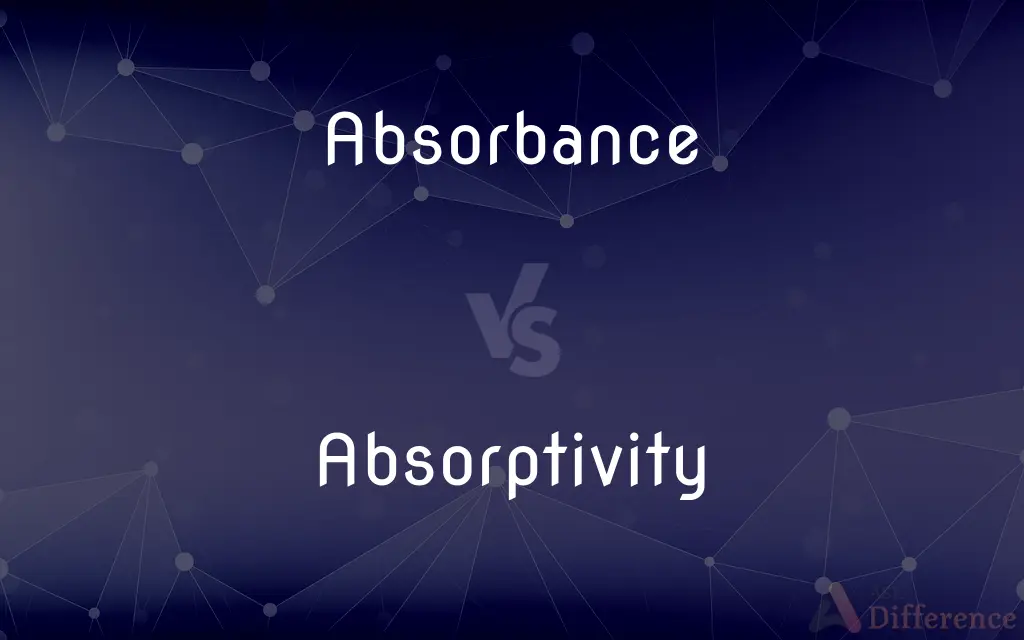Absorbance vs. Absorptivity — What's the Difference?
By Tayyaba Rehman & Urooj Arif — Updated on March 27, 2024
Absorbance measures a material's capacity to absorb light at a specific wavelength, whereas absorptivity defines how well a substance can absorb light per unit concentration and path length.

Difference Between Absorbance and Absorptivity
Table of Contents
ADVERTISEMENT
Key Differences
Absorbance, represented by the symbol A, is a logarithmic measure of the amount of light absorbed by a sample. It depends on the concentration of the absorbing material and the path length of the light through the material. This concept is widely used in analytical chemistry, especially in spectrophotometry, to quantify the concentration of a solute in a solution based on the light absorption at a specific wavelength.
Absorptivity, also known as the molar absorptivity or extinction coefficient and represented by the symbol ε, quantifies the absorbing capability of a substance per unit concentration and path length. It is a fundamental property of the substance, indicating how strongly the substance can absorb light at a given wavelength. Absorptivity is independent of the concentration and the path length, making it a characteristic feature of each substance.
While absorbance is a measure obtained from experimental observations, absorptivity is an intrinsic property of a material that requires knowledge of the concentration and path length for its calculation. For example, in a spectrophotometric analysis, the absorbance of a solution is measured, and then the absorptivity is used to calculate the concentration of the absorbing species in the solution.
The relationship between absorbance and absorptivity is articulated by the Beer-Lambert law, which states that the absorbance (A) of a solution is directly proportional to the concentration (c) of the absorbing species, the path length (l), and the absorptivity (ε) of the species. This law forms the basis for many quantitative analyses in chemical and biological research.
In practical terms, when conducting an experiment to determine the concentration of a solution, absorbance is the directly measured quantity using a spectrophotometer. Absorptivity, on the other hand, is a parameter that must be known or determined from calibration to use the Beer-Lambert law for concentration calculations. This distinction highlights the complementary roles of absorbance and absorptivity in analytical applications.
ADVERTISEMENT
Comparison Chart
Definition
Logarithmic measure of the amount of light absorbed by a sample.
A measure of how well a substance absorbs light per unit concentration and path length.
Symbol
A
ε
Dependency
Dependent on concentration, path length, and substance.
Intrinsic property, independent of concentration and path length.
Measurement
Obtained experimentally through spectrophotometry.
Calculated using the Beer-Lambert law, given absorbance, concentration, and path length.
Usage
Used to quantify the concentration of a solute in a solution.
Used to characterize the absorbing capability of a substance.
Compare with Definitions
Absorbance
Logarithmic measure of light absorption by a sample.
The absorbance of the solution increased with concentration.
Absorptivity
Measures a substance's capability to absorb light per unit.
The absorptivity of the compound was high, indicating strong absorption.
Absorbance
Used in Beer-Lambert law for quantitative analysis.
The law relates absorbance to concentration for analytical purposes.
Absorptivity
Used in calculating concentrations from absorbance data.
Given the absorptivity, the solute concentration was determined.
Absorbance
Dependent on the path length of light through the material.
Doubling the path length doubled the absorbance.
Absorptivity
Independent of the sample's physical dimensions.
Absorptivity remains the same regardless of the path length.
Absorbance
Influenced by the concentration of the absorbing species.
Higher dye concentration led to greater absorbance.
Absorptivity
Intrinsic property, characteristic of each substance.
Gold has a specific absorptivity that is constant under given conditions.
Absorbance
Specific to a particular wavelength of light.
The absorbance at 260 nm is crucial for DNA quantification.
Absorptivity
Essential for interpreting absorbance in spectrophotometry.
Understanding absorptivity is crucial for accurate chemical analysis.
Absorbance
Absorbance is commonly defined as "the logarithm of the ratio of incident to transmitted radiant power through a sample (excluding the effects on cell walls)". Alternatively, for samples which scatter light, absorbance may be defined as "the negative logarithm of one minus absorptance, as measured on a uniform sample".
Absorptivity
The act or process of absorbing or the condition of being absorbed.
Absorbance
(physics) A logarithmic measure of the amount of light that is absorbed when passing through a substance; the capacity of a substance to absorb light of a given wavelength; optical density.
Absorptivity
A state of mental concentration.
Absorptivity
The quality of being absorptive; absorptiveness.
Absorptivity
(thermodynamics) The fraction of radiation absorbed by a surface to the total radiation incident on the surface.
Absorptivity
(analytical chemistry) The constant a in the Beer's law relation A = abc, where A is the absorbance, b the path length, and c the concentration of solution. Also known as absorptive power. Formerly known as absorbency index; absorption constant; extinction coefficient.
Absorptivity
Absorptiveness.
Absorptivity
(physics) the property of a body that determines the fraction of the incident radiation or sound flux absorbed or absorbable by the body
Common Curiosities
What is absorbance?
Absorbance is a measure of how much light is absorbed by a sample at a specific wavelength.
Can absorbance be used to determine concentration?
Yes, absorbance can be used to determine the concentration of a substance when the absorptivity is known.
How are absorbance and absorptivity related?
They are related by the Beer-Lambert law, where absorbance is directly proportional to absorptivity, concentration, and path length.
What does a high absorbance indicate?
High absorbance indicates a high concentration of the absorbing species or a long path length through the sample.
Is absorptivity a constant value?
Yes, absorptivity is a constant for a given substance at a specific wavelength and set conditions.
Why is absorptivity important in spectrophotometry?
Absorptivity is crucial for calculating the concentration of substances in spectrophotometric analyses.
What factors affect absorptivity?
Absorptivity is affected by the molecular structure of the substance and the wavelength of light, but it is an intrinsic property and does not change with concentration or path length.
What does absorptivity indicate?
Absorptivity indicates the ability of a substance to absorb light per unit concentration and path length.
What unit is absorbance measured in?
Absorbance is unitless, as it is a logarithmic ratio of the incident and transmitted light intensities.
Can absorbance change with wavelength?
Yes, absorbance is specific to the wavelength of light used and can vary across different wavelengths.
How do you measure absorbance?
Absorbance is measured using a spectrophotometer by comparing the intensity of light before and after it passes through a sample.
Does temperature affect absorbance or absorptivity?
Temperature can affect absorbance indirectly by changing the concentration or the solvent properties. Absorptivity is generally considered constant but may vary slightly with temperature due to changes in molecular interactions.
Can absorbance be negative?
Theoretically, absorbance values are positive; negative values would indicate an error in measurement or calculation.
Share Your Discovery

Previous Comparison
Relation vs. Relative
Next Comparison
Amygdala vs. HippocampusAuthor Spotlight
Written by
Tayyaba RehmanTayyaba Rehman is a distinguished writer, currently serving as a primary contributor to askdifference.com. As a researcher in semantics and etymology, Tayyaba's passion for the complexity of languages and their distinctions has found a perfect home on the platform. Tayyaba delves into the intricacies of language, distinguishing between commonly confused words and phrases, thereby providing clarity for readers worldwide.
Co-written by
Urooj ArifUrooj is a skilled content writer at Ask Difference, known for her exceptional ability to simplify complex topics into engaging and informative content. With a passion for research and a flair for clear, concise writing, she consistently delivers articles that resonate with our diverse audience.














































